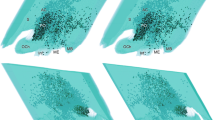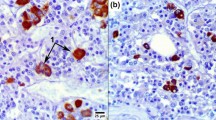Abstract.
Development of thyrotrophs in the rat pituitary at 3, 7 and 10 days after birth was quantitatively studied by labelling the proliferating cells with bromodeoxyuridine (BrdU) and with the proliferating cell nuclear antigen (PCNA), and the immunostaining of thyrotrophs was applied to the same tissue section. Double administration of BrdU at 9:00 h and 19:00 h, increased the numerical volume density (Nv) of labelled cells by about 1.5-fold of that obtained with a single injection at 9:00 h. When PCNA was used to determine hyperplasia, the Nv of labelled cells further increased greatly. In accordance with these results, the Nv of the thyrotrophs that were also labelled with BrdU or PCNA increased likewise. These cells comprised 3–7% of all BrdU- or PCNA-labelled cells, indicating that about 1/20 of the proliferating cells are involved in producing new thyrotrophs. On the other hand, their percentage in all thyrotrophs was 8.8%, 18.4% or 38.7% in 3-day neonates with single or double BrdU injections, or when PCNA was detected. These high percentages indicate a considerable contribution by the mitosis of already existing thyrotrophs to their proliferation in the early postnatal period.
Similar content being viewed by others
Author information
Authors and Affiliations
Additional information
Electronic Publication
Rights and permissions
About this article
Cite this article
Taniguchi, Y., Yasutaka, S., Kominami, R. et al. Mitoses of thyrotrophs contribute to the proliferation of the rat pituitary gland during the early postnatal period. Anat Embryol 206, 67–72 (2002). https://doi.org/10.1007/s00429-002-0283-4
Accepted:
Issue Date:
DOI: https://doi.org/10.1007/s00429-002-0283-4




